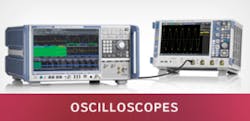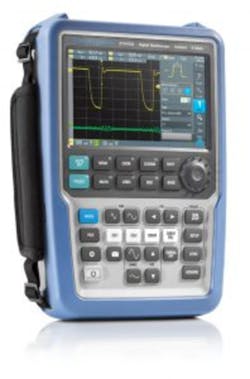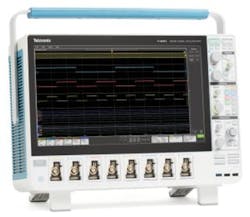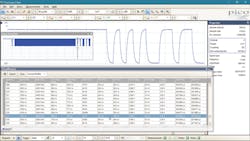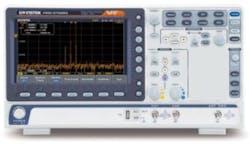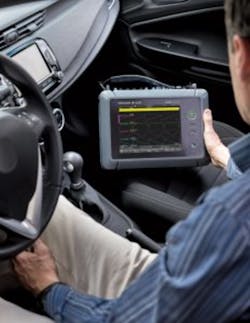Flexibility, usability, and performance are three terms that come to mind to describe the latest oscilloscopes. Recently introduced products offer you a choice of architectures: traditional benchtop and handheld units plus display-free PXIe and USB models that rely on external processors and user interfaces. Many add the functionality of other instruments as well, including spectrum analyzers, power supplies, and DMMs. And whether your user interface is integral to the instrument or implemented on an external computer, you can expect to have access to consumer-friendly touchscreen features. In addition, companies are offering a range of price/performance options.
Rohde & Schwarz has addressed multiple form-factor and price/performance points this year, beginning with the March introduction of the RTB2000 entry-level oscilloscope, which combines 10-bit resolution and touchscreen operation in bandwidths to 300 MHz. The company targets the instrument at education, R&D, and manufacturing.
The company followed up the same month by announcing new triggering and decoding software test options for the 6-GHz R&S RTO2000 Series oscilloscopes that make these instruments suitable for testing fast communications interfaces—including 5-Gb/s SuperSpeed USB and PCI Express 2.0 as well as USB Power Delivery (USB-PD). The high-speed-interface test system consists of the R&S RTO2064 oscilloscope, test options for the various interface standards, and modular R&S RT-ZM60 broadband probes for contacting the DUT.
Addressing multiple instrument functions within a single instrument, Rohde & Schwarz announced in May an integrated arbitrary waveform and pattern generator for its R&S RTO2000 and R&S RTE oscilloscopes, allowing the instruments to deliver test signals on two analog and eight digital channels. The R&S RTO-B6/R&S RTE-B6 arbitrary waveform and pattern generator option provides two analog and eight digital channels operated via controls integrated into the oscilloscope GUI. Each of the two analog channels on the generator has a bandwidth of 100 MHz and can be operated in any of four modes: as a function generator, as a modulation generator, in sweep mode, or for replay of arbitrary waveforms. The waveform generator’s data rate of 500 MS/s and resolution of 14 bits make it suited for development tasks—to characterize components such as differential amplifiers, for example.
The pattern generator can be used to output individually configured digital signals on up to eight channels. With a data rate of up to 40 MS/s, it can generate clock and bus signals such as SPI. Users can operate the fully integrated generator via the large touchscreen. Arbitrary waveforms can also be taken from one of the oscilloscope channels. For example, acquired bus telegrams can be copied into the arbitrary waveform generator at the touch of a button.
Rohde & Schwarz also addressed the handheld form factor when in June it announced it has enhanced its portable R&S Scope Rider (Figure 1), adding triggering and decoding software for the CAN flexible data rate (CAN-FD) and single-edge nibble transmission (SENT) bus systems. The portable oscilloscope can analyze CAN, LIN, CAN-FD, and SENT bus signals, making it suitable for troubleshooting automotive applications—from commissioning to drive tests.
The R&S Scope Rider offers the functionality of eight test and measurement instruments—including protocol, logic, and spectrum analyzers and a data logger for long-term monitoring—in a compact design. This functionality makes the R&S Scope Rider suitable for signal-integrity measurements on serial buses, for example. The fully isolated oscilloscope permits quick and easy differential measurements without the expensive extra equipment typically needed for serial protocols in automotive applications.
Large screen, high resolution
Tektronix has been a pioneer in bringing spectrum analysis to traditional time-domain instruments with its mixed-domain oscilloscopes.1 But this year the company turned its attention to the new 5 Series MSO, which incorporates a 15.6-inch capacitive-touch high-definition (1920 x 1080) display (Figure 2).
The scope offers up to eight input connectors, which Tektronix calls FlexChannels, or the industry’s first reconfigurable oscilloscope inputs. By default, each input is a TekVPI+ connector that accepts all TekVPI analog probes. However, connecting a new TLP058 logic probe converts an input to eight digital channels, allowing for as many as 64 digital channels total. Digital signals are sampled, triggered, and stored the same as analog signals, simplifying comparisons among inputs.
During a demonstration of the new scope at its introduction last spring, Gary Waldo, a product planner at Tektronix, said that with increasing system complexity, engineers are contending with multiple processors, controllers, FPGAs, independent clocks, serial buses, sensor inputs, and power rails and power-conversion circuits. Consequently, he said, “Four analog channels simply aren’t enough for many designs.” Further, he said, the pursuit of lower SNR drives the need for greater vertical resolution—a requirement met by the new oscilloscope’s 12-bit ADCs. A deep analysis of engineers’ needs drove the development of the new 5 Series platform, he said, which includes a new ASIC combining ADC, demux, trigger, and digital acquisition components in a single device, enabling more channels and tight integration between analog and digital channels.
Other companies as well have been addressing high resolution. Pico Technology’s PicoScope 4444 USB oscilloscope, for example, makes differential voltage measurements at 14-bit resolution. And Teledyne LeCroy throughout the year has been demonstrating its HDO9000 high-definition oscilloscope with HD1024 technology at shows ranging from ESC Boston in May to EDI CON USA in September. The scope, introduced last year,2 provides 10-bit resolution and a 4-GHz bandwidth.
High-speed digital
This year, Teledyne LeCroy has been addressing high-speed digital test. In August, the company announced, in conjunction with Anritsu, a partnership to facilitate PCI Express 4.0 (PCIe Gen4) test with a system that integrates the Anritsu Signal Quality Analyzer (SQA) MP1900A BERT with a Teledyne LeCroy 10Zi-A oscilloscope and QPHY-PCIe4-Tx-Rx software. This system enables high-speed IC, device, and network engineers to conduct automated transmitter and receiver compliance tests as well as link equalization verification.
The Anritsu/Teledyne LeCroy system can be expanded to 32 Gb/s, making it the first end-to-end solution to address PCI Express 5.0 (PCIe Gen5) requirements, the companies said. The system will also support PCI Express 3.0 (PCIe Gen3) transmitter, receiver, and link equalization testing for complete PCI Express ecosystem coverage.
“PCIe Gen4 represents a significant test challenge for design engineers,” said Conrad Fernandes, vice president of sales, Teledyne LeCroy, in a press release. “Our collaborative test solution leverages two best-in-class instruments to accurately measure and validate product performance in accordance with the PCI-SIG standards. Recognizing that PCIe Gen5 is expected to emerge within two years, we have protected our customers’ investments by creating a clear and efficient upgrade path that will control test costs.”
Software tool
For its part, Pico Technology has been addressing software and in August introduced the DeepMeasure analysis tool. Included as standard with PicoScope 3000, 4000, 5000, and 6000 Series oscilloscopes, DeepMeasure (Figure 3) delivers automatic measurement of waveform parameters on up to a million successive waveform cycles. Results can be sorted, analyzed, and correlated with the waveform display.
Courtesy of Pico Technology
“Visualizing real-world test data is key to solving many of today’s engineering challenges,” explained Trevor Smith, business development manager for test and measurement at Pico Technology, in a press release. “DeepMeasure is a powerful tool that takes advantage of PicoScope deep-memory oscilloscopes to enable rapid analysis and debug of complex waveforms ranging from serial data streams to laser pulses and particle-physics experiments. Anomalies can be easily pinpointed and correlated with other events captured by the oscilloscope.”
In addition, Pico Technology in March announced an increase in the bandwidth of its PicoScope 9300 family of sampling oscilloscopes with two new 25-GHz models. The USB-controlled sampling oscilloscopes are a cost-effective solution to today’s proliferation of gigabit-per-second data streams and their copper, wireless, and optical fiber interconnect, the company said.
The new 2- and 4-channel 25-GHz models now support fifth-harmonic capture for data up to 10 Gb/s and third-harmonic capture up to 16 Gb/s. These rates, and others in between, are increasingly found in Ethernet, Thunderbolt, USB 3.1, PCIe 4, Rapid I/O, e-SATA, OC-192/STM-64, and OC-256 implementations. All have transmission lines, cables, components, transmitters, and receivers that need precompliance testing and characterization.
PXI oscilloscopes
National Instruments and Keysight Technologies have both introduced PXI oscilloscopes this year. NI, for example, announced a new 100-MHz, 8-channel oscilloscope that builds on NI’s expertise in high-density and software-designed instruments in PXI. The new PXIe-5172 oscilloscope includes a user-programmable FPGA. Engineers can use LabVIEW to customize this oscilloscope’s firmware, such as adding in-line signal processing or advanced triggering. Key features of the PXIe-5172 oscilloscope include a 250-MS/s sample rate, input voltage range of up to 80 V peak-to-peak with ±20 VDC offset, and support for external sample and reference clocks.
Keysight is also offering PXI scopes. In February, the company introduced the M9243A PXIe oscilloscope—built with Keysight’s InfiniiVision oscilloscope technology and providing up to 1 GHz bandwidth for quick analysis and troubleshooting of wideband signals. With a 1,000,000-waveform/s update rate and advanced probing technology, the oscilloscope (Figure 4) enables troubleshooting of random and intermittent signals not easily seen with digitizer technology. Features include cursors and markers, advanced triggering, waveform averaging, masks, and 31 selectable measurements. When the scope is combined with 89600 VSA software, engineers can demodulate and evaluate complex IQ waveforms with a full 1-GHz bandwidth.
Sub-500-MHz benchtop scopes
In addition to Rohde & Schwarz with its RTB2000 entry-level oscilloscope, several other companies have recently introduced benchtop scopes with bandwidths less than 500 MHz. Keysight Technologies, for example, is looking to bring professional measurement capabilities—including mask, math, FFT, and protocol-trigger/decode functionality—to educators and small businesses, according to Mike Hoffman, business development engineer. The 50- and 100-MHz InfiniiVision 1000 X-Series oscilloscopes are priced from $449 to $849, yet they employ the company’s fourth-generation MegaZoom technology to offer 50,000-waveform/s update rates.
“The 1000 X-Series leverages Keysight’s more than 60 years of oscilloscope expertise,” Hoffman said at the time of the introduction in March, adding that the scopes employ custom ASIC technology to combine an oscilloscope and optional WaveGen function generator in a compact form factor.3
National Instruments chose DesignCon in January to introduce its new high-performance model of the VirtualBench all-in-one instrument. The new version includes a 4-channel 350-MHz oscilloscope, vs. a 2-channel 100-MHz scope on the original version, introduced in June 2014. In addition, Ethernet connectivity on the enhanced version complements the original’s USB and Wi-Fi. The new version also boosts the instrument’s programmable power-supply current-output capability, offering outputs of +6, -25, and +25 V at up to 3, 1, and 1 A, respectively (vs. 1, 0.5, and 0.5 A on the original model). The software-based VirtualBench, which requires an external computer for the user interface, also includes a function generator, digital multimeter, and digital I/O.
RIGOL Technologies recently introduced its new DS2000E Series oscilloscope—a 2-channel instrument available with either 100-MHz or 200-MHz bandwidths (Figure 5). All models provide two analog channels with 50-Ω input impedance standard. It offers a real-time sample rate of 1 GS/s (on both channels), memory depth of up to 28 Mpoints standard, and waveform capture rate up to 50,000 waveforms/s. Targeting the basic oscilloscope market, the oscilloscope features an 8-inch WVGA intensity-graded display, network connectivity, hardware waveform record/playback, serial trigger and decode, and other advanced analysis capabilities and is priced starting at $647.
In addition, Saelig Co. Inc. announced that it is offering the GW Instek MDO-2000E Series oscilloscopes, which combine several test instruments in one enclosure (Figure 6). The series includes two instrument combinations: MDO-2000EG models have a built-in spectrum analyzer and a dual-channel 25-MHz arbitrary waveform generator, while the MDO-2000EX models feature a built-in spectrum analyzer, an arbitrary waveform generator, a 5,000-count DMM, and a 5-V, 1-A power supply. The MDO-2000E Series is available in three bandwidths— 70, 100, and 200 MHz—and in 2- or 4-channel models.
Courtesy of Saelig Co. Inc.
And Siglent is offering its SDS2000X Series Super Phosphor oscilloscopes (SPO) available in bandwidths of 70 MHz, 100 MHz, 200 MHz, and 300 MHz with a maximum sample rate of 2 GS/s. Features of the SPO technology, the company said, include a waveform capture rate up to 140,000 waveforms/s (normal mode) or 500,000 waveforms/s (sequence mode), support for 256-level intensity grading and a color temperature display, a record length up to 140 Mpoints, and a digital trigger system.
Scope complements spectrum analyzer
While many oscilloscopes incorporate spectrum-analysis functionality, an oscilloscope can also complement a separate spectrum analyzer. As an example, Rohde & Schwarz at EDI CON USA in September introduced its R&S FSW-B5000 option for the R&S FSW85 signal and spectrum analyzer. An analyzer equipped with the new option makes use of the R&S RTO2064 digital oscilloscope as an external digitizer, providing an equalized 5-GHz signal-analysis bandwidth (Figure 7). The combination can analyze wideband signals such as automotive radar FMCW chirp signals, IEEE 802.11ay signals, and 5G waveform candidates.
Courtesy of Rohde & Schwarz
The amplitude and phase response of the R&S FSW85 together with the R&S FSW-B5000 are fully characterized at the factory across the entire frequency range, the company reports, with the amplitude and phase measurement accuracy guaranteed throughout the measurement bandwidth. The R&S FSW-B5000 supports center frequencies between 9.5 GHz and 90 GHz. For frequencies above 85 GHz, the R&S FSW85 needs to be equipped with the R&S FSW-B90G option, which extends the frequency range up to 90 GHz.
Scope and recorder
Finally, Yokogawa has introduced a new member of its ScopeCorder family, which, the company says, combines the strengths of an oscilloscope and a data recorder. The new portable battery-powered DL350 Scope-Corder offers the same high reliability and precision as the high-end DL850E and DL850EV models, yet it is optimized for testing and troubleshooting in the field.
Courtesy of Yokogawa
The company reports that small data-logging instruments and oscilloscopes have often been used for field test. However, the data loggers lack the ability to measure and record rapidly changing waveforms, and the oscilloscopes accept only voltage signals and cannot continuously record data for long periods. In contrast, the DL350 can measure high-speed changes in voltage, temperature, strain, acceleration, frequency, and in-vehicle serial communication signals (CAN, LIN, and SENT) using a variety of plug-in modules, and it can store up to 50 days’ worth of data when using both its large internal memory and an SD card. The DL350 weighs 3.9 kg, half that of the higher-end DL850E/DL850EV. It offers up to eight analog and 16 digital channels with sample rates to 100 MS/s and resolution to 16 bits.
For vehicle testing (Figure 8), the DL350 has a global positioning system (GPS) function that enables location, speed, time, and other data to be correlated with waveform data collected during vehicle road tests. The DL350 comes with an intuitive touch-screen interface.
References
- Nelson, Rick, “Tektronix emphasizes spectrum analysis for scopes,” EE-Evaluation Engineering Online, Feb. 25, 2014.
- Nelson, Rick, “High-definition oscilloscopes optimize vertical resolution,” EE-Evaluation Engineering Online, Aug. 30, 2016.
- Nelson, Rick, “Low-cost scopes bring professional measurements to educators, small businesses,” Rick’s Blog, EE-Evaluation Engineering, March 9, 2017.
For more information:
About the Author

Rick Nelson
Contributing Editor
Rick is currently Contributing Technical Editor. He was Executive Editor for EE in 2011-2018. Previously he served on several publications, including EDN and Vision Systems Design, and has received awards for signed editorials from the American Society of Business Publication Editors. He began as a design engineer at General Electric and Litton Industries and earned a BSEE degree from Penn State.
